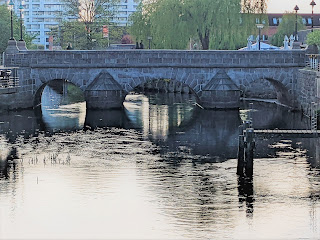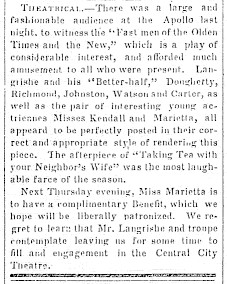Men fought and died in England in the battle of Hastings in 1066. The kingdom and crown passed to a foreigner, William of Normandy.
Search This Blog
Monday, June 27, 2022
The Bayeux Tapestry - an amazing historical source. Lindsay Townsend
Men fought and died in England in the battle of Hastings in 1066. The kingdom and crown passed to a foreigner, William of Normandy.
Wednesday, June 22, 2022
The Perfect Setting
Setting is as integral to a story as the
characters and plot. It can also be important to backstory. When I was
developing the backstory for Anna, the protagonist in The Legacy, I needed her to be from a location in Denmark that was just
north of the German-occupied area of South Jutland in 1874. Farming had to be a
major occupation in the area. I also wanted to be able to locate Anna’s family
home near a sizable city, where her brother could have been employed by a
brewery.
At the time I had not been to Denmark so I
looked at a map from the period and selected the city of Vejle. I researched
the area enough to know it fit my basic criteria. Now that I’ve visited the
city, I’ve learned that Vejle’s beauty and history make it a worthy main
character.
The city is situated in eastern Jutland.
Businesses and residences stand in river valleys and on the slopes of wooded
hills. Green trees provide a lovely backdrop for the numerous brick structures
and tiled roofs.
 |
| Photo by K.A. Knudsen |
Vejle’s name comes from an Old Danish word
meaning “ford,” because the city is located at the convergence of the Vejle and
Greis Rivers at the head of the Vejle Fjord. In Viking times, area wetlands had
to be crossed by the Ravning Bridge, a nearly half-mile wooden structure.
Remnants of the bridge which were discovered buried in the ground date back to
ca.890-985 AD. It is believed to have been built by Harold Bluetooth and his
people, but its purpose is uncertain. Archaeologists’ theories vary from the
bridge being built quickly for troop transport to more mundane purposes such as
allowing traders to transport wares over the swampy area.
 |
| Photo via Wiki Commons |
The first known recorded mention of the
city dates back to 1256, but archaeological digs in downtown Vejle have discovered
that there were homes in the area as far back as 1100. The current St. Nicolai
Church building, in the same downtown area, dates to the 13th
century. Dedicated to the patron saint of merchants and seafarers, the original
church was built in late Romanesque style. Renovations have occurred over the
centuries especially
after incurring serious damage during the Thirty Years War (1618-1848). Since
then there have been several major updates, the most recent being in the 1960s.
The church houses many artifacts, including the remains of the Haraldskær
Woman, one of the best preserved of the Iron Age bog bodies, on display in a glass-covered sarcophagus.
During the Middle Ages, Vejle was an
important market town. Through the 1500s and into the 1600s, the town experienced
prosperity and growth, benefiting from rising exports. Vejle continued to
develop along those lines up to the mid-17th century. In the late 17th and
early 18th centuries, the population decreased due to plague and war.
 |
| Photo is property of author |
The 1801 census showed that Vejle had
approximately 1,300 townspeople. In 1827, a new harbor was established on the
fjord, and in the latter part of the 19th century, a railroad
station and modern utilities set the town on the path to continued growth. Today,
the city’s population is approximately 59,000.
Although my selection was somewhat serendipitous, Vejle is a noble town near which to situate the fictional ancestral home of Anna and the other characters in the Stryker Legacy series.
Buy Links: Paperback at Amazon Amazon print or digital
Monday, June 13, 2022
HISTORY OF THE DRINKING STRAW
Whether paper, plastic, bamboo or glass, people have been sipping through hollow tubes for centuries. Between 6000 to 7,000 years ago, the ancient Mesopotamians invented the very first straws, usually made from wood and, sometimes, gold to reach the beer sitting below fermentation byproducts floating on top.
The first patent for a drinking straw was filed in 1888 by Marvin Chester Stone, a paper cigarette holder manufacturer. The legend goes that he was drinking a mint julep when the piece of rye grass he was using as a straw disintegrated. Determined to make something better, he wrapped and glued strips of paper around a pencil, coming up with the first prototype of paper drinking straws. By 1890, Stone Industrial was mass producing them. Stone promised his customers “health, cleanliness and economy,” with his straws, which reassured some of those who were concerned about catching the myriad diseases of the time. Paper straws allowed them to avoid making direct contact with the glass while drinking. At one point, Stone was producing two million paper straws a day in his factory. Bendy straws were created in the 1930s when inventor Joseph Friedman inserted a screw into the straw, wrapped floss around the screw's grooves, and took out the screw. With indentations, the straw could easily bend without breaking and his young daughter could then easily drink her milkshake.
Straws have been made from precious metals,
grains like wheat and rye, paper, plastic and lots more.
Tracy
Tuesday, June 7, 2022
The Victorian Laundry
The Victorian Laundry
By C. A. Asbrey
Some time ago I did a post on cleaning in the past, and many of the tips and recipes for organic cleaning materials proved very popular. Today I'm going to take us to the laundry and share the secrets of stain removal from days gone by.
Sunday, June 5, 2022
Denver City - June 4, 1861
Post by Doris McCraw
writing as Angela Raines
 |
| Photo Property of the Author |
June, the month of weddings, people getting together, socializing, and traveling. I began to wonder how that would have played out in the early days of the Rocky Mountain West. The one constant newspaper during that time was the Rocky Mountain News, so I went to see what they had to offer. Below are some of the 'articles' from June 4, 1861. Denver City was approximately two years old, and the area was still part of the Kansas Territory.
What I found fascinating in the marriage notice was how they 'gushed' about the groom and his accomplishments, with little said about the bride, other than her name. I do give them credit for waxing poetic with the quote. What do you think?
Thursday, June 2, 2022
New Release The Sheriff (Friendly Creek Book 2) by Agnes Alexander
Friendly Creek Sheriff Buck Beaumont suddenly has his
hands full when several strangers show up in his small town. Though this is
usually a welcoming community, one of the newcomers, Sam Rayfield, doesn’t set
well with sheriff, and Beaumont is not sure just why that is.
Those feelings become clearer when the town’s mayoral
race takes off. Friendly Creek chooses sides between a well-respected,
long-time resident and the smooth-talking Rayfield. It seems that Rayfield has
more than becoming mayor as his goal—he also has marriage on his mind.
Wynona Murdock, the newly hired schoolteacher, revels
in her new-found independence that comes with her job. But Sam Rayfield openly
vies for her attention to the point of making her uncomfortable. Yet, how can
she avoid him, maintain her independence—and stay safe?
With Rayfield’s subtle intimidation of the
townspeople, Sheriff Beaumont gives him a warning he can’t ignore, and forces
his hand. How does the arrival of these strangers connect them to one another,
and to Rayfield? When murders begin to happen, it’s up to Beaumont to unravel
the mystery and keep Wynona safe…or die trying.
EXCERPT
Buck had just
pulled the papers he wanted to work on out of the desk drawer when the peaceful
morning was interrupted by a blast of gunfire.
Jumping up and
heading out the door with his peacemaker in his hand, he saw immediately the
bank was being robbed. Three men ran out and mounted their horses and spurred
them into a fast gallop as they headed out of town. He fired, and one man
tumbled from the saddle.
Hurrying to the
bank as fast as his long legs would take him, Buck rushed inside with several
men following him. He saw Clifford Daniels, the teller, lying in the lobby. He
was moaning in agony, but Charlie had arrived and was headed to help him.
He then saw
Jarvis Pearlman, the owner and president of the bank, leaning beside the safe
with blood pouring from his shoulder. He waved in the direction of the other
side of the room.
Buck’s head
turned quickly to see a woman in the green printed dress crumpled on the floor.
His heart came to his throat as he rushed and swept her up into his arms.
“Oh, God! No!” He
screamed. “It can’t be you, Rebecca.”
Her eyes
fluttered as she looked up at him and whispered, “Don’t grieve, my love. You
made me happy.”
Then, she closed
her eyes and died in his arms.


.jpg)














.png)
